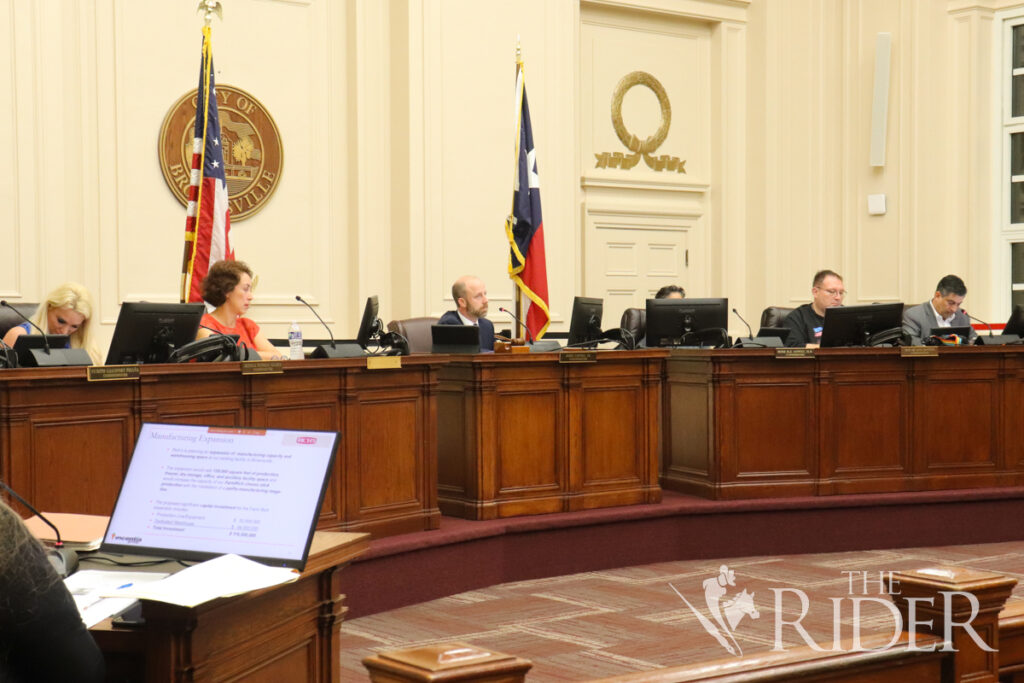
City commission hears proposed charter edits; BPUB provides fund breakdown and timeline
Tuesday night, the Brownsville City Commission listened to the Charter Review Committee interim report, which outlined proposed changes to the city charter.
After a failed motion to remove Brownsville Public Utilities Board Chair Sandra Saenz during a previous meeting held Jan. 3, Mayor Trey Mendez spoke about flaws in the city charter that hinder the commission’s ability to remove members of the utilities board, such as the requirement of a unanimous vote.
Committee member Gerardo Martinez began the presentation by outlining the committee’s goals, such as building a framework of responsibility, communication and governance.
Proposed changes to the charter include changing the majority vote requirement to a supermajority vote in order to appoint members to the utilities board, a change that aims to encourage more due diligence and agreement when choosing members, according to committee member Tomas Tijerina.
Another proposal would change the unanimous vote required to remove board members to a supermajority vote. Variants of this option include removal with cause, given the opportunity for the board members to defend themselves. Tijerina said requiring cause would add a “layer of transparency” to the process.
Martinez also said the committee had to balance its goal of building trust with the community and the potential effects of charter amendments.
“There were potential adverse effects that we took into consideration as well,” Martinez said. “We didn’t want to make a short-term decision and have a long-term negative impact.”

One risk in changing the structure of the utilities board is the potential for a negative bond rating, which could cause an increase in rates for customers.
“Whether that risk could play out to good or bad is not certain at all,” committee member David Merrill said. “I would say that if a rating agency came and looked at Brownsville and [saw the change] from a … mostly autonomous organization to a less autonomous organization with changes that have political implications, yes there is a risk that there could be changes in your bond rating.”
A negatively impacted bond rating would cost ratepayers a “certain amount,” according to Martinez.
“A true downgrade in the utility bond rating would actually result in higher interest costs for future debt issuances,” said Mike Perez, BPUB chief financial officer. “So, this in turn provides pressure on the utilities operations and maintenance costs that could necessitate a request for base rate increases. … If we’re not able to secure those rate increases, then that can impact, of course, the reliability of the system.”
The committee will meet two more times to allow the proposals to be voted on. A meeting is scheduled for 5:30 p.m. today, during which members of the public will be able to comment on each item discussed.
To join the meeting remotely, visit brownsvilletx.webex.com and use meeting number 2592 827 0837. The password for the meeting is “charter.”
Tenaska Project Revenue Analysis
During Tuesday’s meeting, the commission also heard a presentation from the utilities board regarding funds raised for the Tenaska Project.
“Our chair, vice chair and interim [general manager] were unavailable today, so they asked me to be here in their place,” said Patricio Sampayo, chairman of the BPUB finance committee and a member of the City of Brownsville and BPUB joint subcommittee. “With me tonight are members of our finance team as well as members of our communications team to answer any questions.”
Perez went on to present the Tenaska Project revenue analysis, which outlined the breakdown of funds raised for the project.
“We calculated the revenue pre existing before the rate [increases] and then after, with the rate increases, using our rate model worksheet and then we came up with the variance,” he said.
Perez said the funds raised due to rate increases for the project amount to $113,862,918.
The city’s 10% share of that amount was $11,386,293, leaving BPUB with $102,476,625. Of that amount, $73,476,625 “was all returned to the customers as a subsidy toward the fuel and purchase energy charge on their monthly bills,” according to Perez.
The remaining $29 million was set aside into a Tenaska Equity Fund for BPUB capital improvement and was to be used during the construction period of the project, which never came to fruition.
“The numbers that are being presented here are currently being reviewed by our external auditor, Burton McCumber & Longoria, and they’ll be providing a report specifically on the Tenaska Equity Fund by mid February,” Perez said.
To distribute the $29 million, BPUB must first undergo four steps outlined by a bond ordinance.
First a designated financial officer must deliver a certificate to the governing body informing that BPUB is expected to produce sufficient revenue to operate each fiscal year. Step two is that the governing body makes a finding that agrees with this revenue amount for each fiscal year.
Next, BPUB must hire a nationally recognized consulting firm to confirm that returning the $29 million would not impair BPUB’s ability to provide services. Finally, the board must obtain letters from rating agencies confirming the action will not negatively impact BPUB’s bond rating.
“This timeline is a tentative timeline that will take us through April 19 to complete, but we do anticipate [accelerating] this process, and we’ll make sure to work together with the city and make sure that we can expedite the process,” Perez said.





